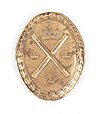
General Lars Herman Tingsten was a Swedish Army officer. He was Minister for War from 1905 to 1907 and Chief of the General Staff from 1919 to 1922.

Naval Staff is the staff of the Chief of the Swedish Navy. Established in 1907, it originated from the Fleet Staff which was established in 1896. The Naval Staff's duties included, among other things to assist the Chief of the Navy with leadership of the Navy's mobilization, training, tactics, organization, equipment and personnel to the extent that such activity was not directly related to operational activities, which was handled by the Defence Staff. In 1994, the Swedish Armed Forces Headquarters took over the Naval Staff's duties. The Naval Staff was reestablished in 2019.
The Royal Swedish Naval Staff College was a Swedish Navy training establishment between 1898 and 1961, providing courses for naval officers. It was the home of the Swedish Navy's staff college, which provided advanced training for officers. It was located within the Stockholm garrison in Stockholm, Sweden.

Artillery Staff in the Swedish Army consisted of commanding officers from the artillery units and had the task of assisting the Master-General of the Ordnance and the Inspector of Artillery in all his activities related questions. It was active between 1807 and 1937.
The Royal Swedish Army Staff College was a Swedish Army training establishment between 1866 and 1961, providing courses for army officers. It was the home of the Swedish Army's staff college, which provided advanced training for officers. It was located within the Stockholm Garrison in Stockholm, Sweden.
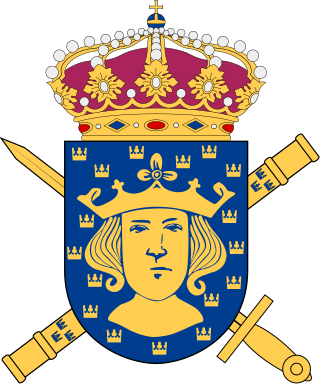
The Commandant General in Stockholm is a military position in Sweden with responsibility for state ceremonial activities. Lieutenant General Michael Claesson, Chief of Defence Staff is the Commandant General in Stockholm since 2020.

The Swedish Army Quartermaster Corps was an administrative corps for personnel within the Swedish Army created in 1880. From the corps, the Swedish Army was provided with staff for various commissary positions. The head of the corps was the Quartermaster-General of the Swedish Army. In 1966, the corps was amalgamated with the Swedish Naval Quartermaster Corps and the Swedish Air Force's quartermaster officers and formed the Quartermaster Corps of the Swedish Armed Forces. It was in turn amalgamated with the Swedish Army Ordnance Corps in 1973 and formed the Commissary Corps of the Swedish Armed Forces which was disbanded in 1990.
The Swedish Army Veterinary Corps was an administrative corps for veterinarians of the Swedish Army from 1887 to 1969. Its task was, in peace as well as in war, to provide army units etcetera with especially trained staff for veterinary positions in the army.
General Staff Corps was an administrative corps within the Swedish Armed Forces between 1937 and 1990 and consisted of Swedish Army officers chosen for duty in the Defence Staff and Army Staff. It replaced the earlier General Staff.
Underlöjtnant was the lowest officer rank in the Swedish Army from 1835 to 1937 instead of the previous ranks of fänrik and cornet. Fänrik was reintroduced in 1914 with the same position as underlöjtnant, from 1926 with lower position.
The Swedish Naval Medical Officers’ Corps was an administrative corps established in 1902 for military physicians in the Swedish Navy and in the Swedish Coastal Artillery. The corps was amalgamated into the Medical Corps of the Swedish Armed Forces in 1969.
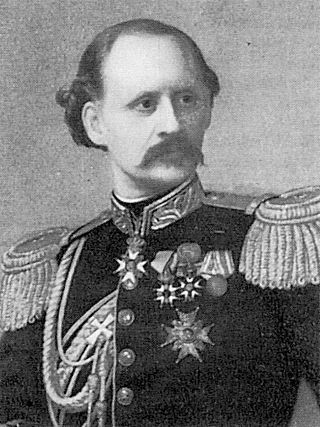
Friherre Major General Claes Fredrik Hugo Raab was a Swedish Army officer. Raab fought in the Second Schleswig War as a volunteer and later in his career became the first Chief of the General Staff. With his international outlook, his concrete experience of the everyday life of the war and his great work capacity, Raab was one of the Swedish Army's foremost officers during the 19th century. He contributed actively to lifting the army out of its difficult recession in the 1860s and initiated the modernization of higher staff functions, officer training and organization which in 1885 would result in a decisive decision on an extension of the conscription defence and rounded off with the replacement of the Allotment system with a conscription-based defence in 1901.

The Quartermaster-General of the Swedish Army was a general officer who was responsible for the Swedish Army Quartermaster Corps, the quartermaster branch of the Swedish Army.
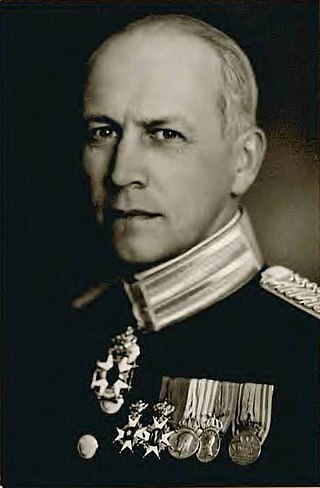
Lieutenant General Carl Henry Tottie was a Swedish Army officer. Tottie's senior commands include Executive Officer of Svea Life Guards, Chief of the Army Staff and the General Staff Corps and military commander of the II Military District.

General Gustaf Fredrik Oskar Uggla was a senior Swedish Army officer. Uggla had a distinguished military career in Sweden during the late 19th and early 20th centuries. Commissioned in 1863, he rose through the ranks, serving in various capacities, including as a teacher at the Royal Military Academy and as a military attaché in Vienna. Uggla's career highlights include commanding the Royal Military Academy and later the 2nd Army Division. He retired as a general in 1913 but continued contributing to military committees.
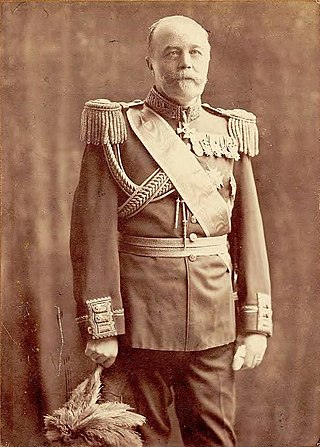
General Hemming Gadd was a Swedish Army officer. His senior commands included regimental commander of the 2nd Life Grenadier Regiment and Svea Life Guards, as well as commander of the 4th Army Division. Gadd served as Chief of His Majesty's Military Staff from 1905 to 1907.
The Fleet Staff was a staff in the Swedish Navy created in 1884, that corresponded to the General Staff in the Swedish Army. It consisted of a commander with the rank of flag officer or captain, as well as a number of officers from the Swedish Navy and the Swedish Coastal Artillery, who were assigned to serve on the staff. The Fleet Staff's tasks included developing plans for the mobilization of the navy and handling issues related to the maintenance and use of naval forces; monitoring and proposing training and exercises for the personnel; monitoring the development of naval warfare both within and outside the country; conducting research in naval warfare history, drafting necessary regulations, and similar tasks; and conducting investigations in maritime military matters. The Fleet Staff was renamed on 31 December 1907 and became the Naval Staff.

Lieutenant General Johan Helge Fritiof Söderbom was a senior Swedish Army officer. Söderbom served as head of the Quartermaster Staff from 1928 to 1935 and was Quartermaster-General and as commanding officer of the Swedish Army Quartermaster Corps from 1935 to 1946.
The War College, originally established by Gustavus Adolphus in 1630, started as a military court but evolved into a central administrative agency responsible for the army. Over time, it underwent several reforms, losing its central role and jurisdiction, and by 1866, it was absorbed into the Royal Swedish Army Materiel Administration. Its functions changed under different monarchs, and it went through multiple reorganizations, including the introduction of departments and the establishment of a General War Court. Despite these changes, its core responsibilities revolved around military administration, such as artillery, fortifications, commissariat, and payroll matters.
The Swedish Naval Quartermaster Corps was an administrative corps of the Swedish Navy. The Swedish Naval Quartermaster Corps was established in 1903 through a parliamentary decision and operated from 1904 to 1966. It included various ranks of naval quartermasters and civilian personnel who performed both military and administrative duties in the Swedish Navy and the Swedish Coastal Artillery. Recruitment involved training quartermaster students, who needed to pass specific educational requirements.

